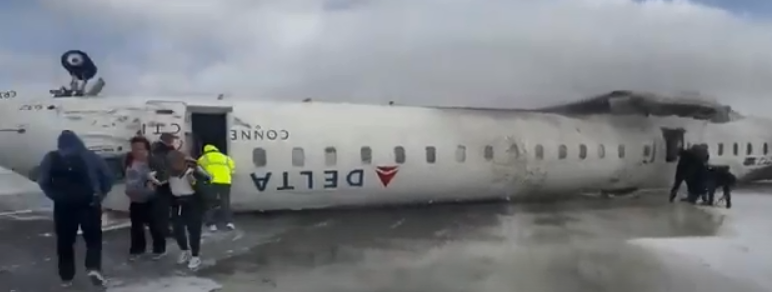Delta Plane Flips Upside Down After Crash Landing in Toronto: A Comprehensive Analysis
On a frigid and snow-laden Monday, Toronto Pearson International Airport became the site of a dramatic and unsettling aviation incident when a Delta Air Lines plane, operating as Flight 4819 and managed by Endeavor Air, crash-landed and flipped upside down. The aircraft, a Bombardier CRJ-900, had departed from Minneapolis-St. Paul International Airport and was carrying 80 passengers and crew members. The crash, which occurred amid severe winter weather conditions, prompted an immediate and large-scale response from emergency crews. While all individuals on board were successfully evacuated, the incident left several people injured, including some in critical condition. This event has since drawn significant attention, raising questions about aviation safety, emergency preparedness, and the impact of severe weather on air travel.
The Flight and Its Journey
Flight 4819 was a routine regional flight operated by Endeavor Air, a subsidiary of Delta Air Lines that specializes in short- to medium-haul routes. The flight originated in Minneapolis-St. Paul, Minnesota, a major hub for Delta Air Lines, and was scheduled to land at Toronto Pearson International Airport, one of Canada’s busiest aviation hubs. The Bombardier CRJ-900, a popular regional jet, is known for its efficiency and reliability, with a capacity of approximately 90 passengers. On this particular journey, the plane was carrying 80 individuals, including passengers and crew members.
The flight proceeded without incident for the majority of its journey. Passengers onboard included business travelers, families, and individuals heading to Toronto for various reasons. The cabin crew, as is standard procedure, conducted safety briefings and ensured that all passengers were comfortable as the plane made its way toward its destination. However, as the aircraft approached Toronto, it encountered increasingly severe winter weather conditions, including heavy snowfall, ice, and reduced visibility. These conditions are not uncommon in the region during the winter months, but they can pose significant challenges for pilots and aircraft, particularly during critical phases of flight such as takeoff and landing.
The Crash Landing
As the plane descended toward Toronto Pearson Airport, the pilots faced a series of challenges that tested their skills and training. Reports indicate that the aircraft experienced issues during its final approach, likely due to a combination of icy runways, strong crosswinds, and limited visibility. Witnesses on the ground described the plane as appearing to struggle to maintain control as it neared the runway. The pilots, relying on their instruments and training, attempted to guide the aircraft to a safe landing.
At approximately 4:15 p.m. local time, the aircraft touched down on the runway. However, instead of a smooth landing, the plane skidded and veered off the runway. The exact cause of the skid is still under investigation, but early reports suggest that icy conditions may have played a significant role. As the plane skidded, it lost control and eventually flipped upside down, coming to rest in an inverted position on the tarmac. The sight of the overturned plane was both shocking and alarming, and it immediately became clear that this was no ordinary landing.
The Evacuation and Emergency Response
Despite the dramatic nature of the crash, the evacuation of the plane was carried out swiftly and efficiently. Passengers and crew members, many of whom were undoubtedly shaken and frightened, were able to exit the aircraft using emergency slides and other evacuation routes. The fact that all 80 individuals on board were evacuated safely is a testament to the training and preparedness of the flight crew and emergency responders.
Peel Regional Paramedic Services, the local emergency medical service responsible for the area surrounding Toronto Pearson Airport, confirmed that 15 individuals were transported to nearby hospitals for treatment. Among those injured, one child and two adults were reported to be in critical condition. The remaining injuries ranged from minor to moderate, with most passengers suffering from bruises, cuts, and other non-life-threatening injuries. The injured were taken to several hospitals in the Greater Toronto Area, where medical teams were on standby to provide care. Hospitals in the region are well-equipped to handle mass casualty incidents, and the response to this event was no exception. Medical professionals worked diligently to assess and treat the injured, ensuring that those in critical condition received immediate attention.
The Role of Weather in the Incident
The severe winter weather conditions at the time of the crash have been identified as a likely contributing factor. Toronto and the surrounding region had been experiencing a prolonged period of cold temperatures, snow, and ice, creating hazardous conditions for both air and ground travel. Runways, despite being treated with de-icing agents, can still become slippery under such conditions, increasing the risk of skidding and loss of control.
Pilots are trained to handle challenging weather conditions, but even the most experienced aviators can face difficulties when confronted with extreme weather. The combination of icy runways, strong crosswinds, and reduced visibility can create a perfect storm of factors that make landing particularly treacherous. In this case, it appears that these conditions may have overwhelmed the pilots’ ability to maintain control of the aircraft during the critical moments of landing.
Investigation and Accountability
In the aftermath of the crash, multiple agencies launched investigations to determine the cause of the incident and identify any factors that may have contributed to it. The Federal Aviation Administration (FAA), the National Transportation Safety Board (NTSB), and the Transportation Safety Board of Canada (TSB) are among the organizations involved in the investigation. These agencies will examine a wide range of factors, including the aircraft’s maintenance records, the pilots’ actions, the weather conditions, and the airport’s runway conditions and emergency response protocols.
One area of focus will be the decision-making process leading up to the landing. Pilots are trained to assess weather conditions and make decisions about whether it is safe to land or if they should divert to an alternate airport. Investigators will seek to determine whether the pilots had sufficient information about the conditions at Toronto Pearson Airport and whether they made the appropriate decisions based on that information.
Another area of investigation will be the aircraft itself. The Bombardier CRJ-900 is a widely used regional jet with a strong safety record, but investigators will still scrutinize the plane’s systems and maintenance history to rule out any mechanical issues that may have contributed to the crash. Additionally, the role of the airline and its operational procedures will be examined to ensure that all safety protocols were followed.
The Impact on Passengers and Families
For the passengers and crew members on board Flight 4819, the crash was a traumatic experience that will likely have lasting effects. Surviving a plane crash is an incredibly harrowing experience, and many of those on board may struggle with psychological and emotional challenges in the days, weeks, and months following the incident. Airlines typically provide counseling and support services to passengers and crew members involved in such incidents, and Delta Air Lines has already announced that it will be offering assistance to those affected.
The families of the injured passengers, particularly those in critical condition, are also facing a difficult and uncertain time. The airline has established a hotline for families to obtain information about their loved ones and has pledged to keep them updated on the status of the investigation and any developments related to the crash.
The Broader Implications for Aviation Safety
This incident has once again brought the issue of aviation safety to the forefront, particularly in the context of severe weather conditions. While air travel is generally considered one of the safest modes of transportation, incidents like this serve as a reminder of the risks involved, especially when external factors such as weather come into play.
Airlines and regulatory agencies are constantly working to improve safety standards and protocols, but there is always room for improvement. This crash may prompt a reevaluation of procedures related to landing in severe weather, as well as the training provided to pilots for handling such conditions. Additionally, airports may need to reassess their runway maintenance and de-icing procedures to minimize the risk of similar incidents in the future.
The Role of Emergency Responders
The swift and effective response of emergency crews played a crucial role in ensuring that this incident did not result in more severe consequences. First responders, including paramedics, firefighters, and airport personnel, demonstrated exceptional professionalism and coordination in their efforts to evacuate the plane and provide medical care to the injured.
The incident also highlights the importance of having well-trained and well-equipped emergency response teams at airports. Airports are required to have comprehensive emergency plans in place, and regular drills and training exercises are conducted to ensure that personnel are prepared to handle a wide range of scenarios, from minor incidents to full-scale disasters.
Media Coverage and Public Reaction
The crash garnered significant media attention, both in Canada and internationally. News outlets provided extensive coverage of the incident, with live updates from the scene and interviews with witnesses, officials, and aviation experts. The dramatic images of the overturned plane were widely circulated, capturing the attention of the public and sparking discussions about aviation safety.
Social media also played a significant role in disseminating information about the crash. Passengers and witnesses took to platforms like Twitter and Facebook to share their experiences and provide updates on the situation. While social media can be a valuable tool for spreading information quickly, it also has the potential to spread misinformation, highlighting the importance of relying on official sources for accurate information.
The Role of Technology in Aviation Safety
Advancements in technology have played a significant role in improving aviation safety over the years. Modern aircraft are equipped with sophisticated systems that help pilots navigate challenging conditions, including advanced weather radar, autopilot systems, and enhanced communication tools. However, as this incident demonstrates, technology alone cannot eliminate all risks, particularly when faced with extreme weather conditions.
In the wake of this crash, there may be renewed calls for further investment in technology that can help mitigate the risks associated with severe weather. For example, improved runway surface monitoring systems could provide real-time data on runway conditions, allowing pilots to make more informed decisions about landing. Similarly, advancements in de-icing technology could help ensure that runways remain safe even in the most challenging weather conditions.
The Human Factor in Aviation Safety
While technology plays a crucial role in aviation safety, the human factor cannot be overlooked. Pilots, air traffic controllers, and ground crew all play vital roles in ensuring the safety of flights, and their training and decision-making are critical to preventing incidents like this one.
In this case, the pilots’ ability to manage the aircraft in challenging conditions will be a key focus of the investigation. While it is too early to draw conclusions, the incident serves as a reminder of the importance of ongoing training and preparedness for aviation professionals. Regular simulations and training exercises that replicate extreme weather conditions can help ensure that pilots are equipped to handle the unexpected.
The Economic Impact of the Incident
Beyond the immediate safety concerns, incidents like this can have significant economic implications for airlines, airports, and the broader aviation industry. The grounding of aircraft, the need for investigations, and potential lawsuits can all result in substantial costs for the parties involved.
For Delta Air Lines and Endeavor Air, the crash represents not only a human tragedy but also a potential financial burden. The airline will likely face increased scrutiny from regulators and the public, and it may need to invest in additional training, technology, or infrastructure to address any issues identified in the investigation.
Similarly, Toronto Pearson Airport may need to review its procedures and infrastructure to ensure that it is prepared to handle similar incidents in the future. This could involve investments in runway maintenance, de-icing equipment, or emergency response capabilities.
The Long-Term Implications for Air Travel
While incidents like this are rare, they can have a lasting impact on public perceptions of air travel. Passengers may become more cautious about flying in severe weather conditions, and airlines may face increased pressure to demonstrate their commitment to safety.
At the same time, the aviation industry has a strong track record of learning from incidents and implementing changes to improve safety. The lessons learned from this crash will likely inform future policies and procedures, helping to ensure that air travel remains one of the safest modes of transportation.
Conclusion
The crash of Delta Air Lines Flight 4819 at Toronto Pearson Airport is a stark reminder of the challenges and risks associated with air travel, particularly in severe weather conditions. While the incident could have had far more devastating consequences, the successful evacuation of all passengers and crew members is a testament to the effectiveness of emergency response protocols and the training of aviation professionals.
As investigations into the crash continue, it is likely that new information will emerge, shedding light on the factors that contributed to the incident and informing efforts to prevent similar occurrences in the future. In the meantime, the focus remains on supporting the injured and their families, as well as ensuring that the lessons learned from this event are used to enhance aviation safety and preparedness.
This incident serves as a powerful reminder of the importance of vigilance, preparedness, and continuous improvement in the aviation industry. While air travel remains one of the safest ways to travel, events like this underscore the need for ongoing efforts to address the challenges posed by severe weather and other external factors, ensuring the safety and well-being of passengers and crew members around the world.



